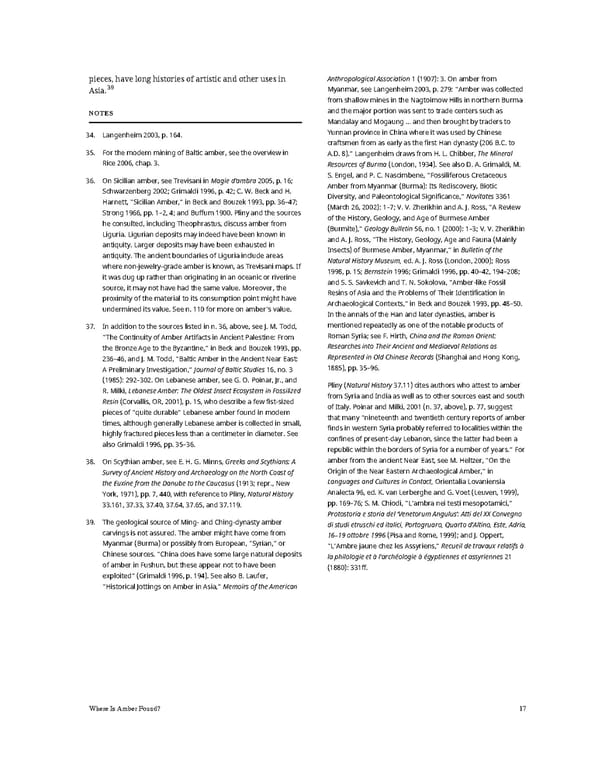pieces, have long histories of artistic and other uses in Anthropological Association 1 (1907): 3. On amber from Asia.39 Myanmar, seeLangenheim 2003, p. 279: “Amber was collected from shallow mines in the Nagtoimow Hills in northern Burma NOTES and the major portion was sent to trade centers such as Mandalay and Mogaung … and then brought by traders to 34. Langenheim 2003, p. 164. Yunnan province in China where it was used by Chinese craftsmen from as early as the first Han dynasty (206 B.C. to 35. For the modern mining of Baltic amber, see the overview in A.D. 8).” Langenheim draws from H. L. Chibber, The Mineral Rice 2006, chap. 3. Resources of Burma (London, 1934). See also D. A. Grimaldi, M. 36. On Sicilian amber, see Trevisani in Magie d’ambra 2005, p. 16; S. Engel, and P. C. Nascimbene, “Fossiliferous Cretaceous Schwarzenberg 2002;Grimaldi 1996, p. 42; C. W. Beck and H. Amber from Myanmar (Burma): Its Rediscovery, Biotic Harnett, “Sicilian Amber,” in Beck and Bouzek 1993, pp. 36–47; Diversity, and Paleontological Significance,” Novitates 3361 Strong 1966, pp. 1–2, 4; and Buffum 1900. Pliny and the sources (March 26, 2002): 1–7; V. V. Zherikhin and A. J. Ross, “A Review he consulted, including Theophrastus, discuss amber from of the History, Geology, and Age of Burmese Amber Liguria. Ligurian deposits may indeed have been known in (Burmite),” Geology Bulletin 56, no. 1 (2000): 1–3; V. V. Zherikhin antiquity. Larger deposits may have been exhausted in and A. J. Ross, “The History, Geology, Age and Fauna (Mainly antiquity. The ancient boundaries of Liguria include areas Insects) of Burmese Amber, Myanmar,” in Bulletin of the where non-jewelry-grade amber is known, as Trevisani maps. If Natural History Museum, ed. A. J. Ross (London, 2000); Ross it was dug up rather than originating in an oceanic or riverine 1998, p. 15; Bernstein 1996; Grimaldi 1996, pp. 40–42, 194–208; source, it may not have had the same value. Moreover, the and S. S. Savkevich and T. N. Sokolova, “Amber-like Fossil proximity of the material to its consumption point might have Resins of Asia and the Problems of Their Identification in undermined its value. See n. 110 for more on amber’s value. Archaeological Contexts,” in Beck and Bouzek 1993, pp. 48–50. In the annals of the Han and later dynasties, amber is 37. In addition to the sources listed in n. 36, above, see J. M. Todd, mentioned repeatedly as one of the notable products of “The Continuity of Amber Artifacts in Ancient Palestine: From Roman Syria; see F. Hirth, China and the Roman Orient: the Bronze Age to the Byzantine,” in Beck and Bouzek 1993, pp. Researches into Their Ancient and Mediaeval Relations as 236–46, and J. M. Todd, “Baltic Amber in the Ancient Near East: Represented in Old Chinese Records (Shanghai and Hong Kong, A Preliminary Investigation,” Journal of Baltic Studies 16, no. 3 1885), pp. 35–96. (1985): 292–302. On Lebanese amber, see G. O. Poinar, Jr., and Pliny (Natural History 37.11) cites authors who attest to amber R. Milki, Lebanese Amber: The Oldest Insect Ecosystem in Fossilized from Syria and India as well as to other sources east and south Resin (Corvallis, OR, 2001), p. 15, who describe a few fist-sized of Italy. Poinar and Milki, 2001 (n. 37, above), p. 77, suggest pieces of “quite durable” Lebanese amber found in modern that many “nineteenth and twentieth century reports of amber times, although generally Lebanese amber is collected in small, finds in western Syria probably referred to localities within the highly fractured pieces less than a centimeter in diameter. See confines of present-day Lebanon, since the latter had been a also Grimaldi 1996, pp. 35–36. republic within the borders of Syria for a number of years.” For 38. On Scythian amber, see E. H. G. Minns, Greeks and Scythians: A amber from the ancient Near East, see M. Heltzer, “On the Survey of Ancient History and Archaeology on the North Coast of Origin of the Near Eastern Archaeological Amber,” in the Euxine from the Danube to the Caucasus (1913; repr., New Languages and Cultures in Contact, Orientalia Lovaniensia York, 1971), pp. 7, 440, with reference to Pliny, Natural History Analecta 96, ed. K. van Lerberghe and G. Voet (Leuven, 1999), 33.161, 37.33, 37.40, 37.64, 37.65, and 37.119. pp. 169–76; S. M. Chiodi, “L’ambra nei testi mesopotamici,” Protostoria e storia del ‘Venetorum Angulus’: Atti del XX Convegno 39. The geological source of Ming- and Ching-dynasty amber di studi etruschi ed italici, Portogruaro, Quarto d’Altino, Este, Adria, carvings is not assured. The amber might have come from 16–19 ottobre 1996 (Pisa and Rome, 1999); and J. Oppert, Myanmar (Burma) or possibly from European, “Syrian,” or “L’Ambre jaune chez les Assyriens,” Recueil de travaux relatifs à Chinese sources. “China does have some large natural deposits la philologie et à l’archéologie à égyptiennes et assyriennes 21 of amber in Fushun, but these appear not to have been (1880): 331ff. exploited” (Grimaldi 1996, p. 194). See also B. Laufer, “Historical Jottings on Amber in Asia,” Memoirs of the American Where Is Amber Found? 17
 Ancient Carved Ambers in the J. Paul Getty Museum Page 26 Page 28
Ancient Carved Ambers in the J. Paul Getty Museum Page 26 Page 28